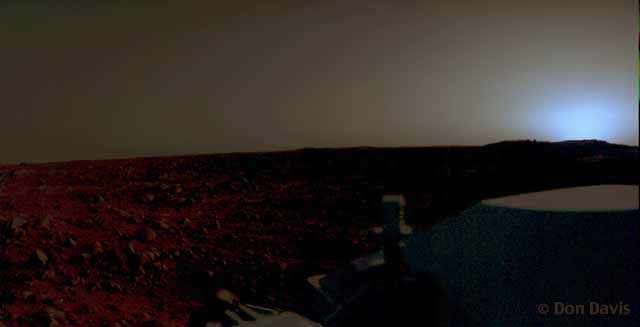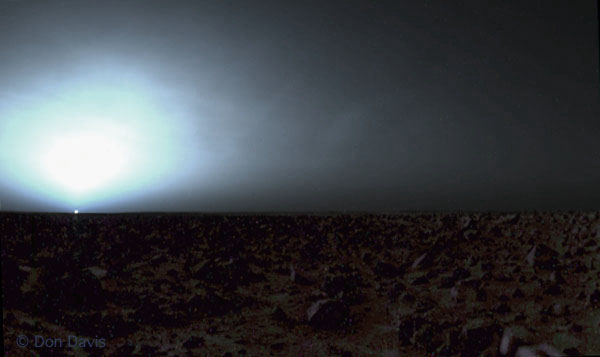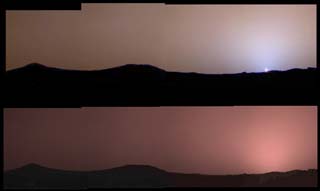The Skies Of Mars
Left: Since Viking 2 landed with an appreciable tilt, allowing more of the skies to be captured by the color panoramic camera. Suspended dust dominates the sky color near the horizon. Directly overhead the sky is probably a very dark gray, with Moons, brighter planets and perhaps a few brightest stars visible. The horizontal streak is not a cloud, but an internal reflection in the camera system.
To the right is a Viking One late afternoon view on a fairly clear day. The bright sky near the sun is apparently a lighter bluish color due to 'forward scattering'. The blue seen here is probably more camera induced than real. On Mars the 'Raleigh scattering' which colors our sky blue is greatly diminished by the low atmospheric pressure. Although no obvious clouds were reported, The horizontal texture in the sky to the left of the overexposed region might just be some weak cloud detail.
Another Viking image shows my efforts to 'hand massage' the data, which was '6 bits' per color channel instead of '8 bit' as in most color computer images. While showing details of rocky textures well, this resulted in areas of gradual shading such as skies looking 'stepped'. I took the original data of the famous sunset image and laboriously 'filled in' the missing gradations of brightness in each color channel by hand, and cleaned up some of the variations in electronic noise in the most underexposed regions. To obtain a less lossy version for publication please contact me.

Viking Two obtained images of morning hazes, and even the thin 'dry ice' frost of the polar regions as in the course of the Martian year they reached the latitude of the Lander. Below is an image processed to show detail in the scenery as well as the sky during a Martian Sunrise. No painterly 'destriping' was done although the overall tilt of the scene was partially removed and brightness levels between the sky and land have been adjusted to show detail in the scenery present in the original data. Hints of cloud texture in or above the morning dusty haze appear to extend well to the right of the regular brightness contours of the sky.


After doing the manual 'destriping' of the Viking 1 sunset panorama I was struck by how much the results resembled those from Pathfinder.
Note the bluish region near the Sun seen by both spacecraft. The lengthening path the sunlight takes through the dust reddens and dulls the twilight glow as the sun further recedes below the horizon. I have darkened the lower image compared to the original release to indicate the dimming of the sky as the sun moves further below the horizon.
Pathfinder used a low resolution digital stereo
camera to obtain filtered images when capturing color information.
Clouds were observed in great qualtity as well
as variety,  including
some images made under virtually overcast conditions.
including
some images made under virtually overcast conditions.
Left: A Pathfinder image taken near Sunset. The forward scattered region near the Sun is dimmed by the dust as well as reddened.
All spacecraft so far successfully landed on Mars have experienced some variety of weather and dusty conditions. In the vertical panorama to the right high altitude clouds loom above the dusty morning twilight. The atmosphere of Earth filters out some of the blue end of the spectrum so what makes it to the ground is our evolutionarily established 'white level'. The 'silvery blueish' cast of sunlight acting on white very high altitude clouds and rocket trails seen on Earth is very striking, perhaps we are seeing a similar effect in the thin clouds above the dust pall of Mars.
Only one instance of color adjusting of Pathfinder images has aroused any concern to me regarding integrity of presentation at the time. This Pathfinder Martian sunrise photo was first released with a pink cloudy sky: A later version of the same picture, on the right, balanced with more care towards presenting what the cameras saw, revealed a much more subdued scene. Clearly the conclusions on cloud lighting and atmospheric conditions will be affected by such colors.